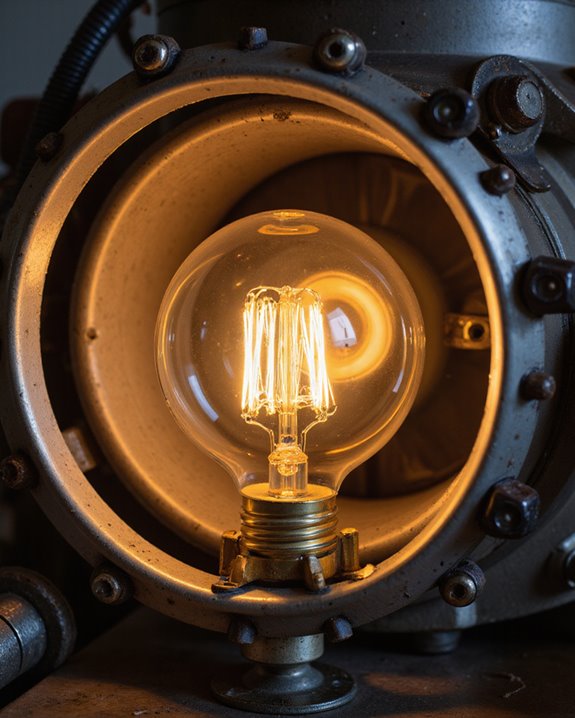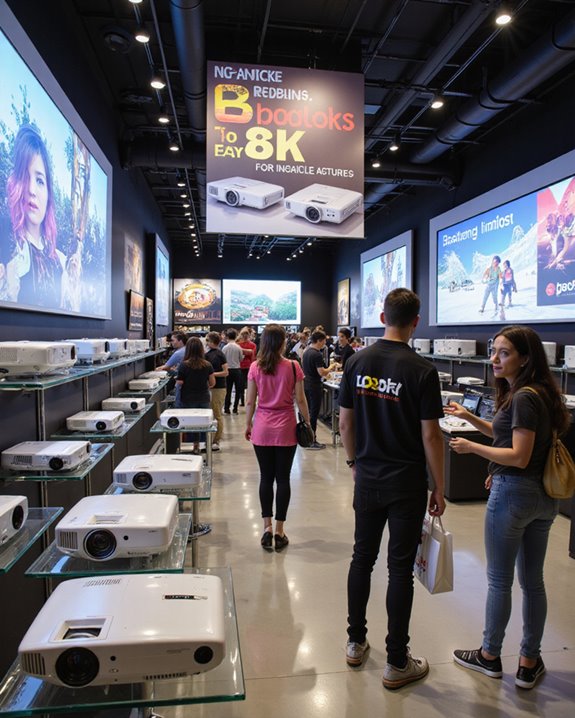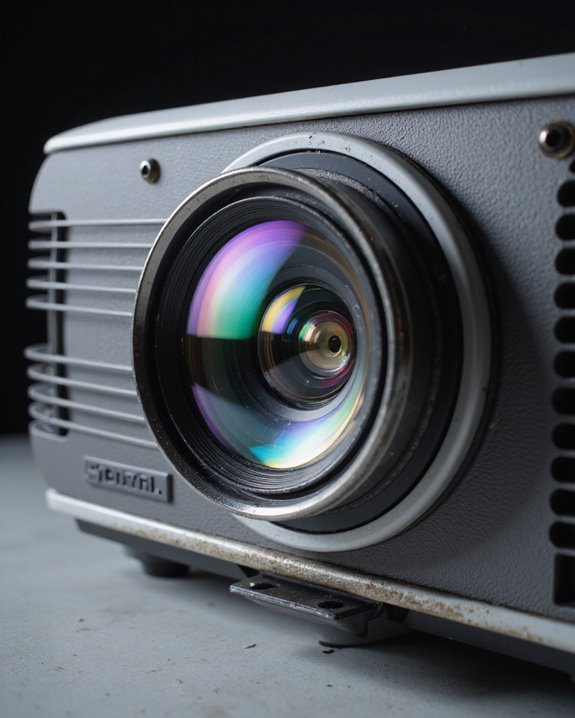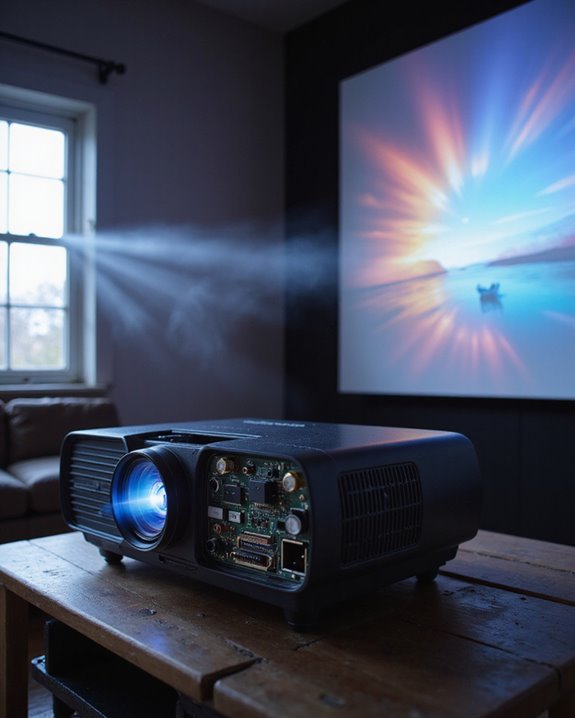Projector lamps use powerful light sources—such as mercury vapor, LED, or laser—to create intense beams for projector TVs. These lamps generate light that is focused by reflectors and passed through filters, color wheels, and optical lenses to form clear, vivid images. Key lamp types include: traditional metal halide (shorter life), LEDs (efficient, long-lasting), and lasers (brightest, most accurate). Modern lamps are more energy efficient and durable than older models. More about lamp technologies, efficiency, and image creation follows.
Key Takeaways
- Projector lamps generate intense light using electrical arcs inside gas-filled bulbs, such as mercury or xenon, to illuminate images.
- Reflectors focus and direct the produced light through the projector’s optical system for maximum brightness and efficiency.
- The light passes through color filters or wheels, creating vibrant, full-color images on the screen.
- Modern projector lamps include traditional bulbs, LEDs, and lasers, each offering different lifespans, brightness, and color accuracy.
- Efficient heat management and specialized filters protect internal components and ensure consistent, high-quality image projection.
Types of Projector Lamps and Their Differences
What sets projector lamps apart from each other, and how do their differences impact performance and longevity? Projector lamps come in several main types, each with unique characteristics affecting color accuracy and power consumption. Metal halide lamps, commonly used in traditional projectors, offer a wide brightness range—measured in lumens—but tend to have shorter lifespans and higher power consumption. Halogen bulbs, though less common, also feature in some models but deliver lower color accuracy.
Comparatively, LED projectors use an array of light-emitting diodes for longer lifespan, lower heat output, and improved energy efficiency, which means reduced power consumption. Laser projectors deliver superior color accuracy and higher brightness, with minimal maintenance. In brief:
- Lamp-based: Wide brightness, lower lifespan, higher power usage
- LED: Longer life, lower heat, better efficiency
- Laser: Best color accuracy, highest brightness
Additionally, the longer-lasting light sources in LED and laser projectors help reduce maintenance costs and downtime over the device’s lifespan.
The Journey of Light Inside a Projector
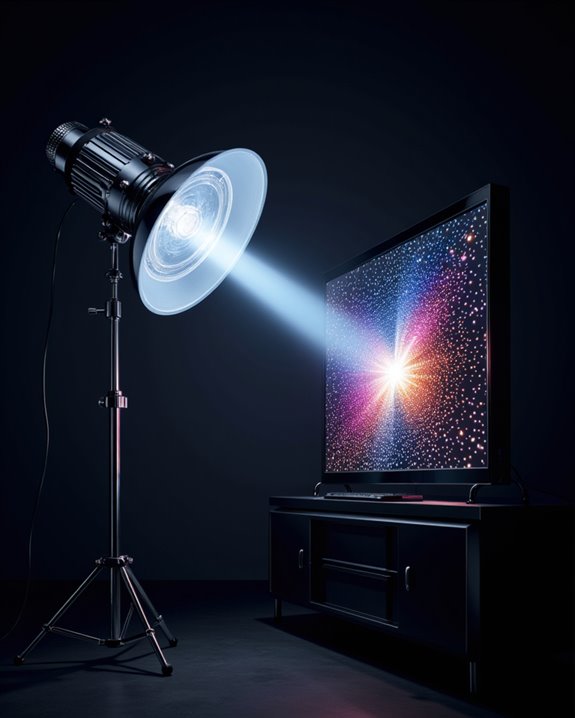
Inside every projector, the journey of light begins when the lamp ignites, producing a powerful beam. This lamp, often filled with mercury or xenon gas, creates an electrical arc that generates intense light. Reflectors—either elliptical or parabolic—focus this light, directing it efficiently through the projector’s optical path. Next, the concentrated beam passes through color filters, which separate white light into red, green, and blue for image clarity and vibrancy. Lenses and mirrors then align and focus the light for sharp projection. The use of advanced LED technology in modern projectors can also influence how the light is produced and managed, enhancing efficiency and image quality. Key components along this journey include: – Fresnel lenses, which help focus the light onto the screen, – High-flow blowers to manage heat and protect the lamp, – Infrared sensors for safety. Some advanced projectors also feature sound integration, enhancing multimedia experiences.
Key Technologies Behind Image Creation
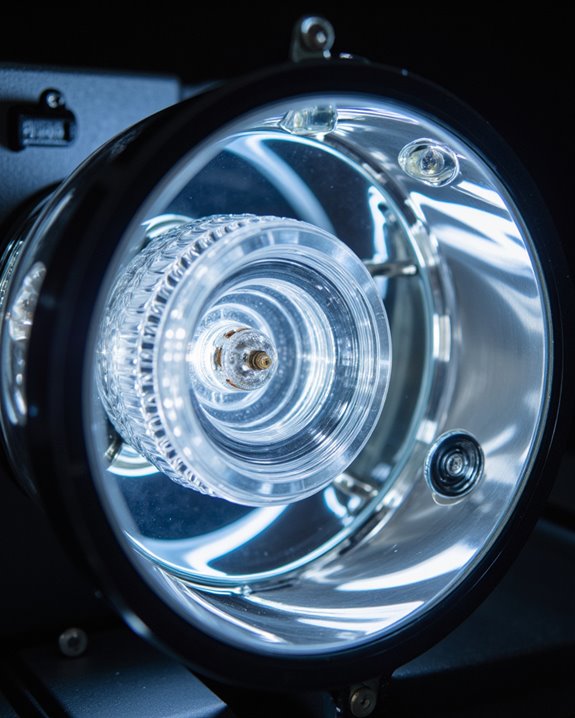
A projector’s ability to create clear, vibrant images relies on several core technologies that work together inside the device. The main light sources include traditional lamps, LEDs (light-emitting diodes), and lasers. LEDs and lasers provide longer lifespans and better color accuracy than lamps, which require periodic replacement. Two primary image creation methods are DLP (Digital Light Processing) and LCD (Liquid Crystal Display) technologies. DLP uses tiny mirrors to reflect light, offering high brightness and video performance. LCD utilizes liquid crystals to control light flow, resulting in accurate color reproduction. Both types depend on precise image processing—where digital signals are converted into visual information—supported by color calibration, a process that guarantees projected colors match the source material. Together, these systems ensure high-quality image output.
Components That Shape Projected Visuals
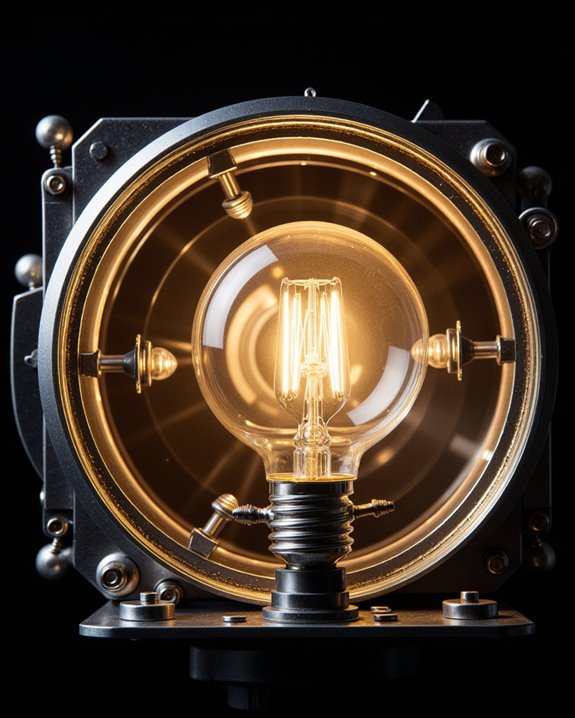
How does a projector transform a simple lamp’s output into a sharp, colorful image on the screen? The process relies on several key components. First, the burner—filled with gases like mercury—creates an electrical arc that generates intense light. This light is directed by the reflector, a mirror-coated glass surface, into the projector’s optical system. Lenses focus and shape the light beam for image clarity, while dichroic prisms and color wheels split or alternate colors, ensuring high color accuracy. Mirrors help guide light efficiently along the optical path. Heat management is vital; ventilation systems dissipate heat from the lamp and optical elements, maintaining performance and safety. UV filters, embedded in the housing or lamp chamber, block harmful ultraviolet radiation and protect internal components. Additionally, lamp brightness directly impacts the vibrancy and clarity of the projected image, making it a critical factor in projector performance.
Efficiency, Longevity, and Environmental Impact
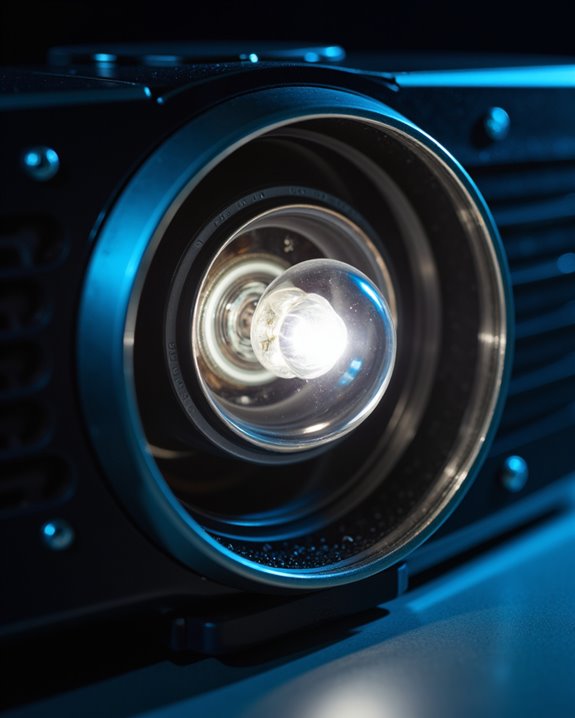
Projector lamp technology directly influences image quality, but it also shapes how efficiently projectors use energy, how long components last, and what impact they have on the environment. Traditional lamp projectors have higher power consumption and lower luminous efficacy (brightness per unit of power) than LED or laser models. Heat dissipation is a concern, as more heat means extra cooling and increased electricity use. Key differences include:
- Traditional mercury lamps typically last 2,000 to 4,000 hours and contain hazardous materials.
- LED and laser projectors use less power, convert more energy to light, and last 10,000 to 20,000 hours.
- Modern projectors reduce waste and carbon impact by requiring fewer replacements and using safer materials.
Responsible recycling and disposal remain essential for all lamp types.
Frequently Asked Questions
How Do I Know When My Projector Lamp Needs Replacing?
One determines when a projector lamp needs replacing by monitoring lamp lifespan and observing replacement indicators such as dimness, flickering, color shifts, indicator lights, or tracking usage hours, ensuring ideal performance before complete failure or significant image degradation occurs.
Can I Replace a Projector Lamp Myself at Home?
Nearly 70% of projector owners replace their own lamps at home, attracted by savings on replacement costs. With basic tools and safety precautions, users can extend lamp lifespan and effectively manage maintenance without professional assistance.
What Safety Precautions Should I Take When Handling Projector Lamps?
When addressing lamp handling, individuals should wear appropriate safety gear, avoid direct eye exposure, allow the lamp to cool, guarantee proper ventilation, and handle the lamp gently to prevent breakage, burns, or exposure to hazardous substances like mercury.
Are Projector Lamps Compatible Across Different Projector Brands?
Exploring brand compatibility and lamp interchangeability can feel like searching for a unicorn—true universal projector lamps are rare. Most lamps are specific to each brand and model, though some aftermarket options offer limited compatibility across certain brands.
How Should I Dispose of an Old Projector Lamp?
When considering lamp disposal, individuals should prioritize environmental safety by utilizing recycling facilities, local collection programs, or specialized drop-off points for hazardous waste, ensuring proper packaging and handling to prevent mercury contamination and comply with local regulatory guidelines.

